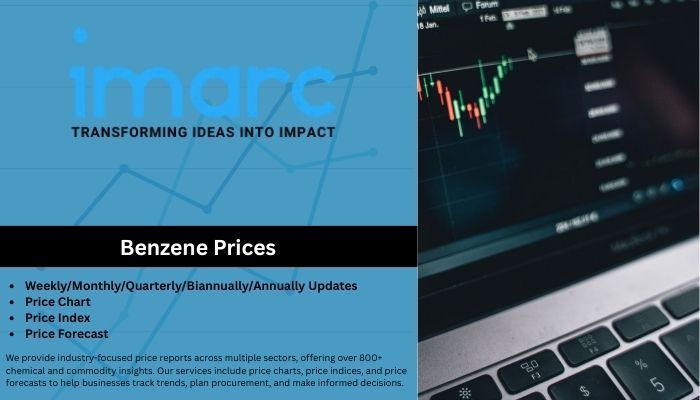Benzene Price Report & Index 2025 | IMARC Group

Benzene Price Trends in North America: Q1 2025 Breakdown
Benzene Prices in the United States:
In early 2025, the Price of Benzene in the USA reached 862 USD/MT, shaped by fluctuating crude oil prices, subdued industrial demand, and persistent inflationary pressures. The Benzene Price Forecast Data highlighted market stability in January post-holidays, but limited growth potential due to weak downstream demand from polymers and solvents. These factors combined to restrain significant price hikes, reflecting cautious sentiment across key industrial segments.
Get the Real-Time Prices Analysis: https://www.imarcgroup.com/benzene-pricing-report/requestsample
Note: The analysis can be tailored to align with the customer's specific needs.
Benzene Price Trends in APAC: Q1 2025 Breakdown
Benzene Prices in China:
In early 2025, the price of Benzene in China declined to 993 USD/MT, impacted by falling crude oil and naphtha prices, alongside sluggish industrial demand. The Benzene Price Forecast Data indicated a consistent downward trend, fueled by overcapacity in the petrochemical sector and global economic uncertainties. Trade tensions and limited consumption further weakened market momentum, reflecting persistent pressure on Benzene prices throughout the first quarter.
Benzene Prices in India:
In early 2025, Benzene prices in India declined to 938 USD/MT, influenced by falling crude oil and naphtha feedstock costs and reduced demand for polymers and solvents. The Benzene Price Forecast Data indicates a bearish market outlook, further pressured by global trade uncertainties and the petrochemical sector overcapacity. Despite minor supply disruptions, weak support from the styrene segment sustained downward pressure on the Price of Benzene throughout the quarter.
Regional Analysis: The price analysis can be extended to provide detailed benzene price information for the following list of countries.
China, India, Indonesia, Pakistan, Bangladesh, Japan, Philippines, Vietnam, Thailand, South Korea, Malaysia, Nepal, Taiwan, Sri Lanka, Hongkong, Singapore, Australia, and New Zealand, among other Asian countries.
Benzene Price Trends in Europe: Q1 2025 Breakdown
Benzene Prices in Germany:
In early 2025, Benzene prices in Germany reached 923 USD/MT, showing notable volatility driven by fluctuating feedstock costs and weak demand from downstream sectors such as polymers, aromatics, and solvents. The Benzene price Index reflected this instability, with a short-lived rise in January followed by subdued market conditions. Limited industrial activity and lack of sustained demand growth contributed to the overall bearish price environment during the quarter.
Benzene Prices in Brazil:
In early 2025, Benzene prices in Brazil declined to 730 USD/MT, influenced by weak demand across key sectors such as polymers, aromatics, and solvents. The drop in crude oil prices reduced production costs, but economic instability and ongoing trade uncertainties kept overall demand low. The Benzene price trend reflected this downward pressure, with limited recovery signals due to decreased activity in the country's major benzene-consuming industries.
Regional Analysis: The price analysis can be expanded to include detailed benzene price data for a wide range of European countries:
such as Germany, France, the United Kingdom, Italy, Spain, Russia, Turkey, the Netherlands, Poland, Sweden, Belgium, Austria, Ireland, Switzerland, Norway, Denmark, Romania, Finland, the Czech Republic, Portugal, and Greece, along with other European nations.
Factors Affecting Benzene Price Trend, Index, and Forecast
Understanding the dynamics behind benzene price movements is essential for industry professionals, traders, and analysts. Benzene, a key petrochemical, is influenced by a variety of global and regional factors that shape its pricing, index, and outlook.
Crude Oil and Feedstock Prices
Benzene is primarily derived from crude oil refining and coal tar. As such, fluctuations in crude oil prices have a direct impact on benzene production costs. When crude oil prices rise, the cost of producing benzene increases, pushing market prices upward. Similarly, the availability and cost of feedstocks like naphtha and coal tar also affect supply and pricing.
Supply and Demand Dynamics
The benzene market is highly sensitive to changes in both supply and demand. Industrial sectors such as automotive, packaging, electronics, and chemicals drive demand for benzene and its derivatives. Supply disruptions—caused by plant shutdowns, maintenance, or logistical issues—can tighten the market and elevate prices. Conversely, increased supply or reduced demand, such as from cheap imports or lower manufacturing activity, can lead to price declines.
Regional Production and Consumption Patterns
Different regions have unique drivers and challenges:
North America: Strong demand from automotive, packaging, and chemical industries, with prices often influenced by raw material costs and regulatory requirements.
Asia-Pacific: Rapid industrialization and expanding petrochemical sectors, especially in China and India, drive robust demand and price volatility.
Europe: Mature market with stable demand, but growth is moderated by strict environmental regulations and a shift toward sustainable production.
Middle East: Major exporter due to abundant oil reserves and large-scale petrochemical production, influencing global supply dynamics.
Regulatory and Environmental Policies
Environmental regulations, particularly in North America and Europe, can increase production costs by requiring cleaner technologies and stricter safety standards. These policies may also limit benzene supply, further impacting prices.
Economic and Geopolitical Factors
Global economic health, inflation, currency exchange rates, and geopolitical tensions all play a role. Economic downturns can reduce industrial demand, while geopolitical events in key producing regions can disrupt supply chains and create price volatility.
Market Speculation and Futures Trading
Activity in benzene futures markets can cause price fluctuations as traders react to anticipated changes in supply, demand, or geopolitical developments. Inventory levels at refineries and chemical plants also signal market tightness or surplus, affecting short-term pricing.
Technological and Industry Trends
Investments in sustainable manufacturing and alternative feedstocks may influence long-term supply and cost structures. The development of bio-based or alternative chemicals could reduce benzene demand over time.
Benzene Price Index and Global Alignment
Benzene prices are closely aligned across the world’s major economic regions—North America, Europe, and Asia—due to high trade volumes and relatively low transportation costs. The export price from South Korea to China often serves as a global benchmark, ensuring that regional prices remain in sync, though short-term divergences can occur before market forces restore alignment.
Benzene Price Forecast
Market Growth: The global benzene market is expected to grow steadily, driven by demand from ethylbenzene and other derivatives.
Price Volatility: Benzene prices are projected to remain volatile, influenced by crude oil prices, supply chain disruptions, and regulatory changes.
Capacity Expansion: Asia, led by China, is anticipated to dominate global benzene capacity growth, supported by expansion in key industrial sectors.
FAQs regarding Benzene Price Trends, Index, and Forecast
What is the current trend in Benzene prices?
Benzene prices are currently experiencing fluctuations, influenced by factors such as feedstock costs (especially crude oil and natural gas), geopolitical tensions, and operational issues at production facilities. While there might be short-term volatility, the overall market is showing growth driven by downstream demand.
What are the primary factors influencing the Benzene price index?
The benzene price index is significantly influenced by crude oil prices, as benzene is primarily derived from petroleum. Other key factors include demand from downstream industries (especially styrene, cumene, and ethylbenzene for applications in automotive, packaging, and construction), global trade policies and tariffs, environmental regulations, and supply chain disruptions (like plant shutdowns or natural disasters).
What is the forecast for Benzene prices in the coming years (e.g., 2025-2030)?
The benzene market is projected to exhibit robust growth in the coming years. Various reports indicate a Compound Annual Growth Rate (CAGR) of around 3.9% to 6.4% through 2029 or 2034. This growth is largely driven by increasing demand from expanding end-use industries, particularly in the Asia-Pacific region.
How is the Benzene price index generally calculated or determined?
Benzene prices are primarily determined by global market mechanisms, with a single worldwide price often benchmarked by export prices from major producers like South Korea to China. Price reporting agencies gather data from market participants (producers, consumers, traders) on transactions, bids, offers, and other market information. The calculation often involves assessing spot prices, contract prices, and factoring in production costs from different processes (e.g., catalytic reforming of naphtha, fractional distillation of coal tar).
Which regions are currently leading the Benzene market, and what are their key drivers?
The Asia-Pacific region currently dominates the benzene market, driven by rapid industrialization, high production capacities, and increasing demand from burgeoning economies like China and India in sectors such as chemical, packaging, automotive, and pharmaceuticals. North America is also expected to witness significant growth due to its expanding petrochemical sector.
Key Coverage:
- Market Analysis
- Market Breakup by Region
- Demand Supply Analysis by Type
- Demand Supply Analysis by Application
- Demand Supply Analysis of Raw Materials
- Price Analysis
- Spot Prices by Major Ports
- Price Breakup
- Price Trends by Region
- Factors Influencing Price Trends
- Market Drivers, Restraints, and Opportunities
- Competitive Landscape
- Recent Developments
- Global Event Analysis
How IMARC Pricing Database Can Help
The latest IMARC Group study, “Benzene Prices, Trend, Chart, Demand, Market Analysis, News, Historical and Forecast Data 2025 Edition,” presents a detailed analysis of the Benzene price trend, offering key insights into global Benzene market dynamics. This report includes comprehensive price charts, which trace historical data and highlight major shifts in the market.
The analysis delves into the factors driving these trends, including raw material costs, production fluctuations, and geopolitical influences. Moreover, the report examines Benzene demand, illustrating how consumer behaviour and industrial needs affect overall market dynamics. By examining the intricate relationship between supply and demand, the prices report reveals key factors that influence current and future prices.
About Us:
IMARC Group is a global management consulting firm that provides a comprehensive suite of services to support market entry and expansion efforts. The company offers detailed market assessments, feasibility studies, regulatory approvals and licensing support, as well as pricing analysis, including spot pricing and regional price trends. Its expertise spans demand-supply analysis alongside regional insights covering Asia-Pacific, Europe, North America, Latin America, the Middle East, and Africa. IMARC also specializes in competitive landscape evaluations, profiling key market players, and conducting research into market drivers, restraints, and opportunities. IMARC’s data-driven approach helps businesses navigate complex markets with precision and confidence.
Contact us:
IMARC Group
134 N 4th St., Brooklyn, NY 11249, USA
Email: [email protected]
Tel No: (D) +91 120 433 0800
United States: +1-631-791-1145
Note: IndiBlogHub features both user-submitted and editorial content. We do not verify third-party contributions. Read our Disclaimer and Privacy Policyfor details.







